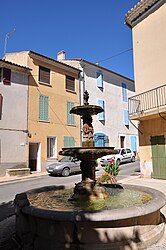Quinson: Difference between revisions
m Remove unused region and department parameters from Template:Infobox French commune to prevent confusion INSEE field is used now. See Wikipedia:Bots/Requests_for_approval/Lonjers_french_region_rename_bot |
Rescuing 1 sources and tagging 0 as dead. #IABot (v1.1) |
||
| Line 76: | Line 76: | ||
==References== |
==References== |
||
*[http://www.insee.fr/en/home/home_page.asp INSEE] |
*[https://web.archive.org/web/20071124142010/http://www.insee.fr/en/home/home_page.asp INSEE] |
||
{{reflist}} |
{{reflist}} |
||
Revision as of 15:31, 21 July 2016
You can help expand this article with text translated from the corresponding article in French. (December 2008) Click [show] for important translation instructions.
|
Quinson | |
|---|---|
 The fountain in Quinson | |
| Country | France |
| Region | Provence-Alpes-Côte d'Azur |
| Department | Alpes-de-Haute-Provence |
| Arrondissement | Digne-les-Bains |
| Canton | Riez |
| Government | |
| • Mayor (2008–2014) | Jean-Michel Reymond |
| Area 1 | 28.11 km2 (10.85 sq mi) |
| Population (2008) | 440 |
| • Density | 16/km2 (41/sq mi) |
| Time zone | UTC+01:00 (CET) |
| • Summer (DST) | UTC+02:00 (CEST) |
| INSEE/Postal code | 04158 /04500 |
| Elevation | 353–584 m (1,158–1,916 ft) (avg. 380 m or 1,250 ft) |
| 1 French Land Register data, which excludes lakes, ponds, glaciers > 1 km2 (0.386 sq mi or 247 acres) and river estuaries. | |
Quinson is a commune in the Alpes-de-Haute-Provence department in southeastern France.
History
Prehistory
In the nearby Gorges du Verdon, there are a number of caves (known as "baumes"), which were occupied intermittently for over 400,000 years. The most significant of these caves is the "Baume Bonne", which has been studied by various archaeologists, including Henry de Lumley.
The Baume Bonne was occupied first during the end of the Lower Paleolithic, 400,000 years ago. It was occupied again 150-300,000 years ago. Tools made using the Levallois technique have been found dating from this era. Neanderthals inhabited the caves later, around 130,000 years ago. Remains of cave bears dating from this period have been found. The Neanderthals were eventually succeeded by Cro-Magnon men, who occupied the cave during the Upper Paleolithic. Finally, modern humans lived in the cave during Neolithic.
Population
| Year | Pop. | ±% |
|---|---|---|
| 1765 | 769 | — |
| 1793 | 1,011 | +31.5% |
| 1806 | 929 | −8.1% |
| 1821 | 927 | −0.2% |
| 1831 | 949 | +2.4% |
| 1836 | 1,024 | +7.9% |
| 1841 | 987 | −3.6% |
| 1846 | 962 | −2.5% |
| 1851 | 913 | −5.1% |
| 1856 | 850 | −6.9% |
| 1861 | 813 | −4.4% |
| 1866 | 1,005 | +23.6% |
| 1872 | 798 | −20.6% |
| 1876 | 763 | −4.4% |
| 1881 | 721 | −5.5% |
| 1886 | 593 | −17.8% |
| 1891 | 587 | −1.0% |
| 1896 | 546 | −7.0% |
| 1901 | 519 | −4.9% |
| 1906 | 486 | −6.4% |
| 1911 | 445 | −8.4% |
| 1921 | 345 | −22.5% |
| 1926 | 376 | +9.0% |
| 1931 | 345 | −8.2% |
| 1936 | 301 | −12.8% |
| 1946 | 274 | −9.0% |
| 1954 | 261 | −4.7% |
| 1962 | 218 | −16.5% |
| 1968 | 225 | +3.2% |
| 1975 | 251 | +11.6% |
| 1982 | 232 | −7.6% |
| 1990 | 274 | +18.1% |
| 1999 | 350 | +27.7% |
| 2008 | 440 | +25.7% |


